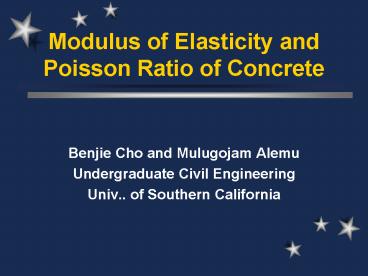Modulus of Elasticity and Poisson Ratio of Concrete - PowerPoint PPT Presentation
1 / 18
Title:
Modulus of Elasticity and Poisson Ratio of Concrete
Description:
Modulus of Elasticity and Poisson Ratio of Concrete. Benjie Cho and Mulugojam Alemu. Undergraduate Civil Engineering. Univ.. of Southern California. Objective ... – PowerPoint PPT presentation
Number of Views:1259
Avg rating:3.0/5.0
Title: Modulus of Elasticity and Poisson Ratio of Concrete
1
Modulus of Elasticity and Poisson Ratio of
Concrete
- Benjie Cho and Mulugojam Alemu
- Undergraduate Civil Engineering
- Univ.. of Southern California
2
Objective
- Find the Modulus of Elasticity of Concrete
- Find Poissons Ratio of Concrete
3
Introduction
- Compressive Strength of Concrete
- Standardardized test of concrete
- American Society for Testing and Materials (ASTM)
- Specifications include
- Correct mix
- Properly affixing strain gauges
- Properly capping the cylinder with sulfur
4
Procedure
- Select (5) 4in diameter by 12in length concrete
with 28-day age with 4 ksi design strength. - Cap all the bearing surfaces with sulfur to make
the end flat. - Mark area where strain gauges will be attached.
- Clean area with chemical cleaners and sand paper.
5
Procedure
- Affix strain gauges on their designated area, one
vertical and one horizontal, using glue. - Attach wire to strain gauges by soldering.
- Test voltage of the strain gauges.
- Place and center samples on the Satec Universal
Testing Machine. - Connect the wires to the P3500 strain indicator,
which in turn is connected to a computer for
recording.
6
Procedure
- Set gauge factor to 2.055 /- .5 and zero the
strain readings. - Begin loading the specimens and record values of
strain for given loads. - Continue testing until failure of the specimen.
7
Organizing the data
- Compute the stress by dividing the load by the
cross-sectional area. - Graph the strength against the vertical and
horizontal strains of each specimen. - Find values for the Youngs Modulus and Poissons
ratio from the data. - Calculate the theoretical values the Youngs
Modulus and Poissons ratio.
8
Calculation procedures
- Youngs Modulus
- E(s1-s2)/(e2-.000005)
- s1The stress corresponding to the longitudinal
strain of 50 micro strain. - s2The stress corresponding to .4f c.
- E2The longitudinal strain corresponding to s2.
- Based on ASTM C 469
- Poissons Ratio
- n(Lateral Strain)/(Longitudinal Strain)
9
Example
10
Cylinder 2
11
Cylinder 3
12
Cylinder 4
13
Cylinder 5
14
Selected Values of Stress and Strain
15
Selected Values of Stress and Strain
16
Data
17
Conclusion
- All specimens performed under the theorectical
values of E. - Average E 2.60E6 psi
- Average Poisson Ratio .119691
18
Conclusion
- Concrete performed to design specifications.
- E 1.5 - 5 ksi
- n .1
- Xiao, Yan. Experimental Analysis of Engineering
Materials. University of Southern California
lecture notes 2002.































